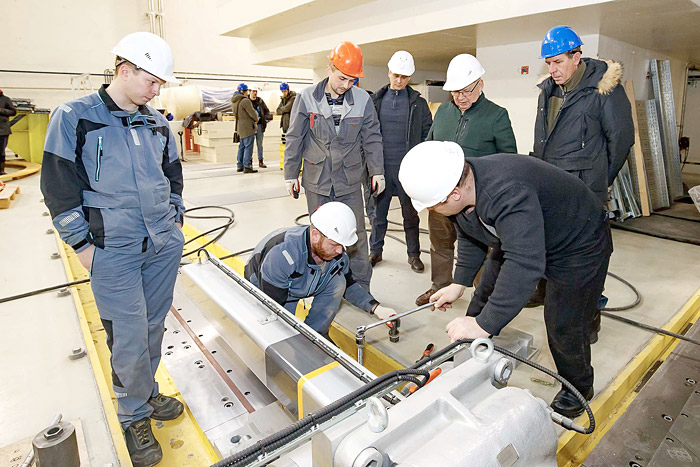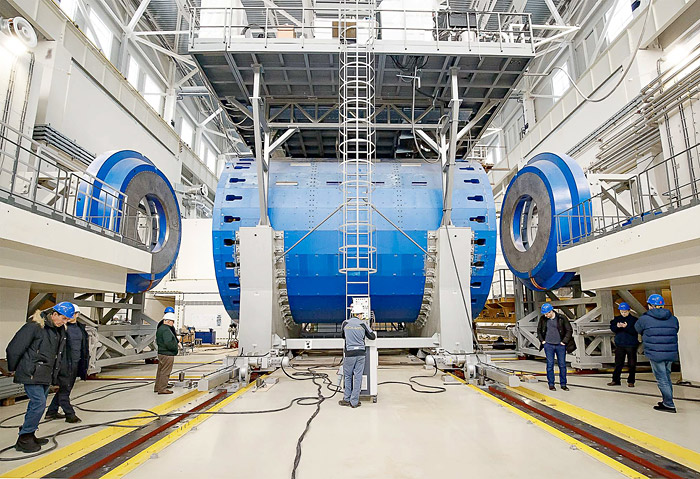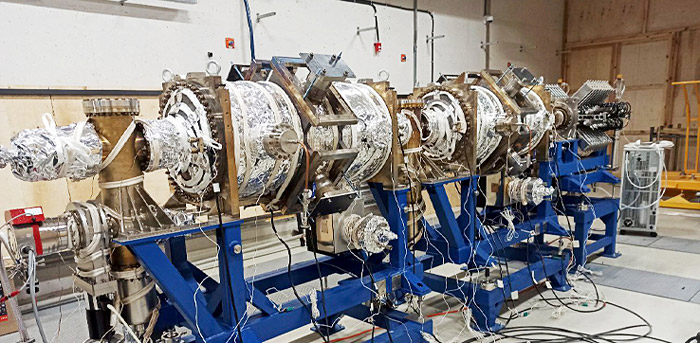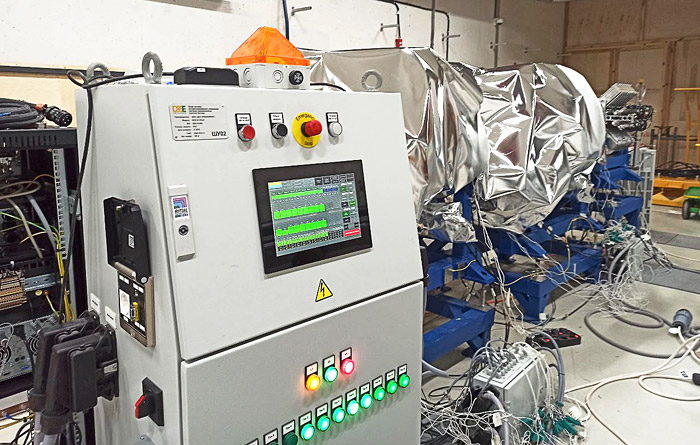
Electronic english version since 2022 |
The newspaper was founded in November 1957
| |
Projects of the XXI century
At the NICA complex:
the MPD solenoid was transported
On 5-6 December, the technological transportation of the 800-ton solenoid of the MPD experiment was held in the pavilion of the multipurpose detector of the NICA accelerator complex.

The detector, together with the side electronics platform, was moved to the working position - the beam position. After adjusting the operating position and test combining water cooling pipes to it, the solenoid is returned back to its original position, or assembly area, where project participants will begin assembling the MPD subdetectors.
Transporting to the beam position from the park position with a total length of about 10.5 m was divided into several stages of 1.5 m each: first, the movement system was brought into readiness, then, at a speed of 3 mm per second, the solenoid with the platform was shifted along special rails, which it is positioned on. The upper contact surface of the rails was adjusted in height with an accuracy of 0.4 mm and the straightness of the side surface of the base rail was adjusted with an accuracy of 0.2 mm. Thus, at each stage, the movement of the massive detector, imperceptible to the naked eye, occurs in approximately 8 minutes 20 seconds. Preparing the movement for the next stage takes 5-6 minutes.

As Deputy Chief Engineer of the Laboratory of High Energy Physics of JINR, Chief Designer of the NICA/MPD project Nikolay Topilin noted, the entire process of transporting the detector is much faster than at CERN, where such an operation takes about 10 minutes and preparation for it takes about two hours. As Nikolay Topilin said, for the MPD, the transportation system that is widely used all over the world was redesigned - an original technique of installing the support developed in the laboratory was used. "This saves a huge amount of time," the chief designer of the project emphasized. He said that the transportation system allows moving about one thousand tons - approximately how much a solenoid with all the "stuffing" - subdetectors - will weigh in the future.
"We were faced with the task of transporting the entire magnetic circuit to the beam axis and adjusting it horizontally and vertically with an accuracy of 2 mm. Afterwards, this object will stand for 2-3 days, when water cooling pipes are combined to it. Then, when we place the magnets in the correct position, they will combine the pipes in that position. After this, we will dismantle the pipes and return the magnet to its original position, in which it will stand for quite a long time - to the standard position for installing the detectors," Nikolay Topilin commented.

"Technological transportation is held, water cooling is combined, the circuits of the side electronics platform are tested, as well as, in principle, the technological possibility of transportation is checked taking into account the infrastructure of installed cryogenic flexible pipelines and the positioning of the solenoid relative to the theoretical axis of the accelerator," VBLHEP Deputy Chief Engineer Konstantin Mukhin explained.
On 11 December, project participants transported the solenoid back to park to assemble the detectors. Based on the results of transporting and adjusting the magnet, its position was fixed with zero deviation vertically and 0.9 mm horizontally.
"In addition, later, we want to check the installation of the poles in the magnetic circuit itself in order to close the magnet complex to the assembly position without subdetectors," Konstantin Mukhin added. With the coils installed, power systems and magnetic field measurements inside the solenoid will be tested. After the magnetic field is measured, the coils will be removed and cryogenic cooling to operating temperatures of 4.5 K will continue from the new year. Project participants will begin to install the power frame and afterwards, to assemble subdetectors.
installation of RF systems has started
The Institute of Nuclear Physics SB RAS and the Laboratory of High Energy Physics of JINR have started work on installing stations of high-frequency accelerating systems HF-1 and HF-2 in the rectilinear gaps of the NICA collider.
VBLHEP employees, together with colleagues from Novosibirsk, install resonators of RF systems in their places in the tunnel and warm them up to achieve a working vacuum. At the same time, rooms for the resonator control system are currently prepared. Vacuum equipment specialists install all the necessary seals, pumps and heating control systems. On 11 December, the operating warm-up temperature was reached. Head of the Group of Accelerating and Developing RF Systems at the VBLHEP Collider Alexander Malyshev talks about the details.
Such work can be carried out at temperatures from 220 to 300 ° C - the specific temperature depends on the pumping rate and what gases remain inside. In this case, hydrocarbons, the occurrence of moisture, argon and nitrogen interfere with the process the most. To obtain a good vacuum in the accelerator, when the flying particle does not collide with the residual gas, the vacuum volume must be completely cleared. Warming up accelerates the diffusion of residual gas from the inner surface of the vacuum chamber."

Stations are preparing to warm up
Specialists face two difficulties. Since the resonator of the RF system has a geometrically complex structure, heating occurs unevenly and depends on such parameters as the ability to wind a sufficient number of heaters and well isolate the heated area from heat loss. In addition, there are places in the resonator that, in principle, cannot be heated. Thus, in the outer part of the HF-1 resonator, amorphous iron is used that does not have a crystal lattice and therefore has good magnetic permeability, but does not tolerate heating. In conditions where the outer part of the resonator should not heat up above 80 °C, but the inner part, on the contrary, should warm up, many layers of insulation and systematic control of even heating are required.

Warming up process. Temperature readings in different areas are displayed on the monitor
The resonators will be kept at elevated temperatures for several days, followed by leak testing. Colleagues from Novosibirsk that have developed these resonators need to be shown that the supplied equipment has the required parameters.
Upon reaching the design parameters of the vacuum, further work will be related to the control system for RF stations: specialists will be engaged in connecting resonators, installing and connecting generators and signal cables.
Currently, the wiring of utilities in two of the six rooms for the resonator control systems is prepared, including pipelines for the water cooling system of the resonators and generators, power routes and signal cables. After all this, the generators will be combined to the resonators, afterwards, the electrical testing stage will begin, when each individual resonator will be tuned, tested and its electrical parameters will be checked.
This is the second group of resonators to be installed at the collider. In summer, resonators were installed on the lower ring of the collider. Today, one HF-1 resonator and four HF-2 resonators are installed on the upper ring. Thus, this year, the installation of all resonators of the HF-1 and HF-2 systems will be completed.
According to the project, the collider will have three high-frequency systems in total. HF-1 is responsible for accumulating the required beam intensity and extra acceleration of particles if required. HF-2 is used to form the required number of bunches and preliminary grouping of the beam. HF-3 will serve to compress particle bunches to a design length of 0.6 m - the resonator for it is under development and the third system itself will operate at the stage of full configuration of the NICA complex.
Based on the information from the JINR Press Office